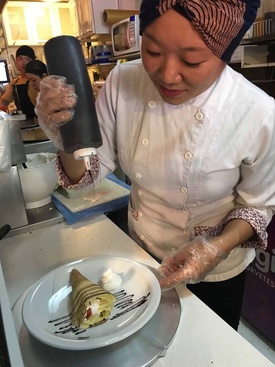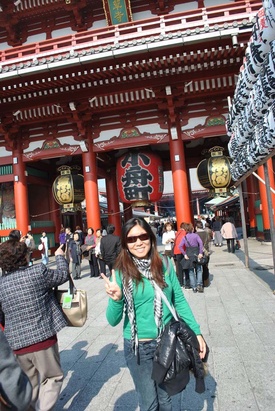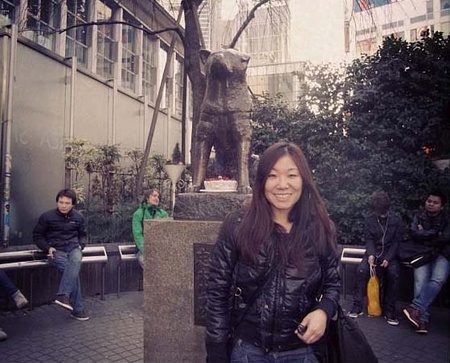
A descendant of the prefectures of Hiroshima, Shizuoka and Saitama, businesswoman Miriam Ishikava, 36, who is Sansei , says that “it has always been a colony”.
Childhood and adolescence were phases full of activities, which included piano and keyboard; going out to karaoke, where he sang only Japanese songs; karate training; as well as swimming and table tennis.
She also participated in Seicho-No-Ie for seven years, which brought her together with other young people in a hip hop ( street dance ) dance group aimed at Nikkei . Sometimes people told Miriam that if she had been born in Japan, she would be an idol .
And his heart has always been there, where he has gone a few times to do arubaito and also for a walk. “I think I know Japan more than Brazil,” he says.
Experiences in Japan
The desire to get to know Japan was so great that he decided to do arubaito when he was still in school. “At 15 years old, I already really liked things in Japan, right? Because my mother is very traditional, she was always very kibishii , you know? Since I was little, I helped in the cafeteria I used to have.” Even though the mother thought it would be too difficult for her daughter, Miriam was determined. She made all the preparations and embarked for Japan alone.
“I think it was quite an experience”, he says. And he reveals that he loved working in bentoya and reveals that he is not afraid of challenges. He thought it was good to be punctual with schedules and concerned about cleanliness – “Japanese is very strict, right?” Maybe that's why her boss didn't get her attention. “As I grew up that way, at home, it was something to prove that this is really how Japanese is. And about security, you just say: 'Wow, a great place!'”, he comments and laughs.
This precocious characteristic has existed since the businesswoman was a child and determination also kept her mother calm. But there is a good reason for this: Miriam is the oldest sister, she has four brothers. “I was always the Neechan who did everything”, because I helped take care of them.
Then, when I was 19 years old and had finished my second year of college, I did an internship to basically pay for my course and realized that I needed to change this situation. Therefore, he dropped out of college to go to Japan in order to save money. And in this second experience in Japan, he stayed for two years in Okasaki, Aichi. Miriam says that there are many Brazilians there and she only spoke Portuguese. “It felt like I was in Brazil, practically. At that time, I think I even became more Brazilian [laughs] than I already was.”
The third time she went to Japan, she became interested in taking a scholarship to study in Japan, because “I was a little tired of working in Brazil”. He only knew a little bit of Japanese from listening at home and, therefore, he began to dedicate himself to studying Japanese for the intermediate level of the language proficiency certification, the Noryoku Shiken (Japanese-Language Proficiency Test – JLPT). But at that time, because of economic instability around the world, many scholarships were cut. So, he left the bag aside and decided to make arubaito again.
At that time, he started helping Saitama's kenjinkai , because he contacted the entity to find out about scholarships and realized “they really needed young people to help the kaikan itself”. He decided to help with the Japan Festival and gradually began to participate in other events held by the association.
After about two months, I already had the documentation prepared and was in Japan making arubaito in a food factory, practically on the border with Tokyo. He stayed there from the end of September until March 2011. “I spent four, five months working a lot. I worked from seven in the morning until eight at night, every day. It was too much”, he confesses.
And, at the beginning of 2011, there was the jishin (tsunami) which, in Miriam's opinion, “disrupted everything”. In Saitama there was a lack of water and food. “I was going to stay a little longer, the goal was to go to London to study English and return to Brazil. I didn’t have a goal, the thing was backpacking.” He even tried to go to London, but agencies said it wouldn't be possible to leave, only to return to his home country, and the airports were being closed.
“In the end, I wanted to stay to help, but I ended up coming back”, he laments. “My mother wanted me to leave. So I left , I had a boyfriend at the time, I bought a ticket from here and I came back.” He then got a new job and opened the creperie that same year – he was running both at the same time until he started dedicating himself exclusively to his own business.
The inspiration for the creperie

This last trip to Japan gave the idea for the business, because Miriam used to eat the sweet and missed it. “I lived 10-15 minutes away from Asakusa. I just took the train quickly and got off in Shibuya. Shibuya and Harajuku are from the same district, right? Very close. So that was my walk, I took a photo with the dog [Hachiko], walked a little, because I like it there, Shibuya, or started in Harajuku, right? This whole journey was what I did on my yasumi ”, he says. It was like that every Sunday.
The next step, after deciding to open the store, was to create a name. Several American names were suggested to her, but for the businesswoman she would have a Japanese name. “'Hachi', because this idea of eating crepes started there, and that made me want to open the store. Shibuya doesn't work, nor does Harajuku, right? [laughs] It has to be an easy, cute name.” And he continues: “The logo I thought of as Hachi, the dog, calls eight, which is also the lucky number, is inspired by the story of the dog. So eight, luck, two eights and create a clover, two eights, two infinities. I think like that, an eternal Hachi, something like that.”

The menu is inspired by Japanese crepes and parfaits and some are adapted to Brazilian tastes. The setting is also influenced by the country, including J-pop and K-pop songs, but it also has a personal touch. “I leave everything I like to do at home. Full of messages, signatures on the wall and Japanese magazines for the customer to enjoy alongside the crepe and have that feeling of being in a cozy and different place”, he explains.
The Japanese side
“I was someone who was always a 'colony' since I was a child,” he says. She studied at a school where there were many Nikkei , the same group that lived in the same building as Miriam. Then, she went to a state school and there she thinks the concept of descendants changed a little.
“Sometimes I have this habit of saying that certain Japanese customs only the Japanese have. I think the Japanese is very right. At this point, we were like that since we were children, everyone helped with things, and my mother is serious, follows the rules, is punctual”. For the businesswoman, this helps a little in her daily life and at work she says that I have always stood out for being like that too, for having become a differentiator.
Miriam says that she tries to be like Japanese, welcoming customers with “hi”, “welcome” or “ irashaimase ”, “good afternoon”, “good morning, how are you?” and a smile on your face. Because, in Japan, “you will hear 'thank you' ten times, because you went into a store to see a deal”.
This concern is not just at the creperie, but with friends too. If she confirms that she is going to an appointment and, in the end, cannot, apologize and explain why. “I don’t think everyone is like this. [laughs] I don’t know if that’s a big part of my house too, my parents were always like that”, he reflects.
Thus, the businesswoman sees herself as a reserved person, with responsibility and commitment, always wanting to do the right thing and think about others, and imagines that these values will take with her.
Not so Japanese
For many, Miriam does not appear to be of Japanese or Brazilian descent. Sansei recalls a situation she went through when a salesperson spoke in English and thought she was a foreigner, but not from Japan. And she was surprised when he said that the Nikkei friend she was with seemed Brazilian.
The question that remains is what is the difference between the two and whether it could be the hair color. “There are people who sometimes think I’m Chinese. Or a mix of Chinese and Filipino, anything. I don’t know, it’s crazy [laughs].”
Another culture that has a great influence on a businesswoman’s life is Korean. An uncle – not by blood – lived with the family for almost ten years and was very close to Korean culture “which is not very different from Japanese”. Furthermore, having lived in the dance group not only with Japanese descendants, but with Koreans as well, I listened to K-pop.
Perhaps Miriam summed up in one sentence what we could say is the definition of Nikkei living in Brazil. “If you mix Brazilian culture there is a lot of good things, the balance”.
© 2018 Tatiana Maebuchi





